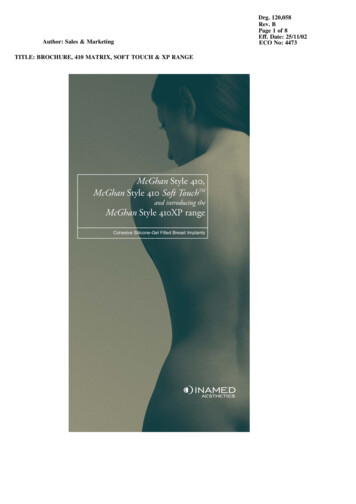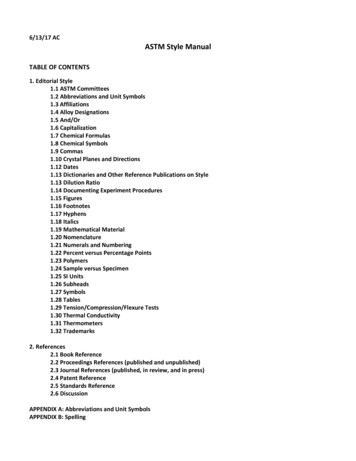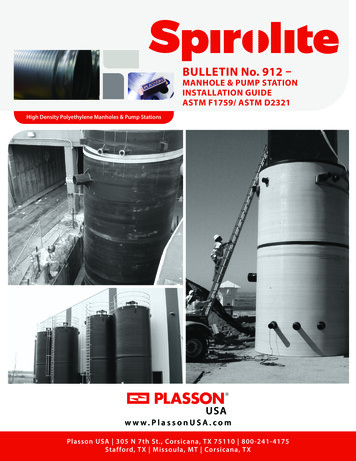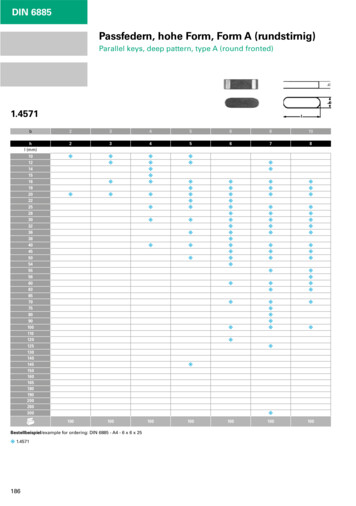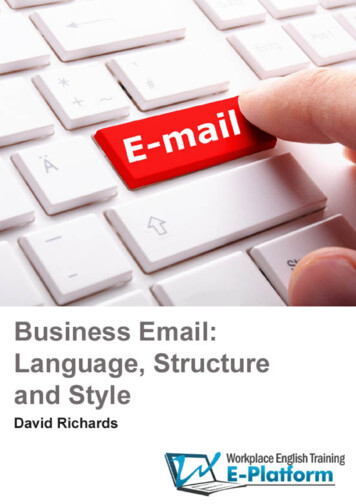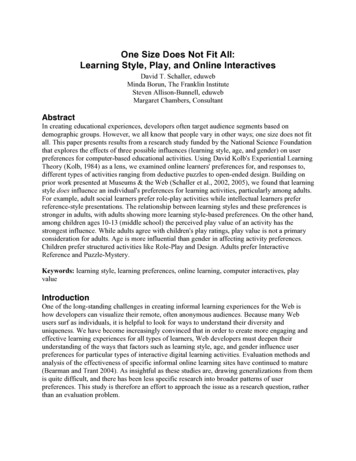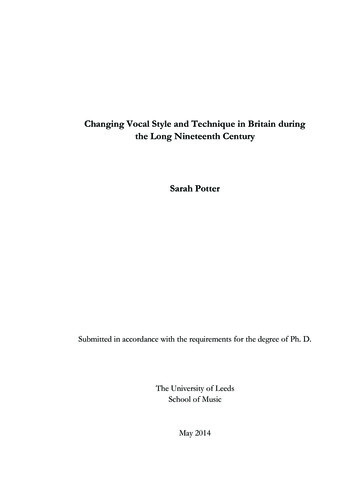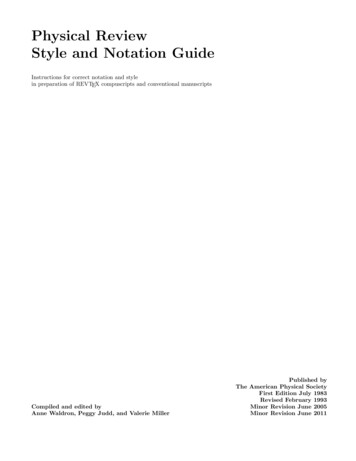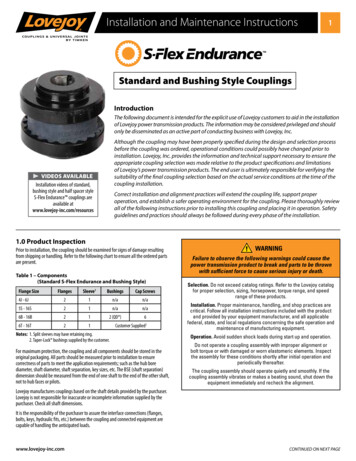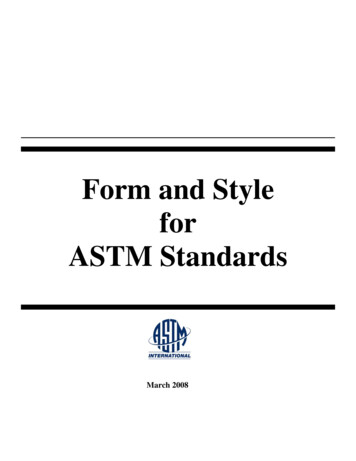
Transcription
Form and StyleforASTM StandardsMarch 2008
CONTENTSPagePreface .vIntroduction.viDefinitions .viiPart A. Form of ASTM Test Methods . A-1Part B. Form of ASTM Specifications. B-1Part C. Form of Other Types of ASTM Standards . C-1Part D. Use of the Modified Decimal Numbering System . D-1Part E. Terminology in ASTM Standards. E-1Part F. Legal Aspects in Standards—Special Instructions . F-1Part G. Standards Style Manual. G-1Part H. Use of SI Units in ASTM Standards .H-1Summary of Changes . .Changes-1Index .Index-1
PREFACEASTM International (hereafter referred to as ASTM International or ASTM), founded in1898, is a scientific and technical organization formed for “the development of standards oncharacteristics and performance of materials, products, systems, and services; and the promotionof related knowledge.” It is the world’s largest source of voluntary consensus standards.The purpose of this manual is to promote uniformity of form and style in ASTM standards.Such uniformity is desirable because it helps the user to find what is needed more easily and tounderstand what is read more quickly. Such uniformity in a manuscript is necessary if it is to bepublished by ASTM International. Deviations from ASTM style may mean wasted time on thepart of authors, reviewers, editors, and eventually the reader of the standard. This means costlytime and resources are lost by everyone involved.Section 10.8 of the Regulations Governing ASTM Technical Committees requires that thecurrent edition of this manual be followed in the writing of standards. When conditions precludecompliance with this manual, a committee may request an exemption from the Committee onStandards (COS).Responsibility for the Form and Style for ASTM Standards is vested in the Board ofDirectors. Revisions to this manual may be recommended by the Board of Directors, by theCommittee on Standards, or by a technical committee or its Executive Subcommittee. TheCommittee on Standards acts upon recommendations for changes and reviews all requests fromtechnical committees for exceptions to the Form and Style for ASTM Standards. Recommendedchanges to this manual in technical substance and format shall be referred to the Committee onStandards, which, at a regular meeting, shall rule on the merits of the recommendation. Acircular letter ballot will be issued to the technical committees and the responses will beaddressed by COS. The COS recommendation shall be sent to the Board of Directors. Changesadopted by the Board of Directors shall be announced to the members and shall become effectiveon the date determined by the Board of Directors.Suggestions for editorial revision of this manual should be addressed to the StaffCoordinator—Form and Style Manual, ASTM International, 100 Barr Harbor Drive, PO BoxC700, West Conshohocken, PA 19428-2959.v
INTRODUCTIONThis manual is the basic textbook for anyone writing an ASTM standard. A study of Parts A,B, C, or E will show the proper form for the principal types of standards including a detailedexplanation of how to write each section, from the title to the appendixes. Within Parts A, B, C,and E, the first section lists the preferred sequence of headings and indicates whether thesesections are mandatory. The headings identified as “mandatory” are required. Other headingsshall be included when the subject matter is pertinent to the document under development, inwhich case, all instructions and guidance for that particular section shall be followed. Forexample, if the standard does not contain reference to any standard documents within the text, itis not required to include a section on Referenced Documents. If, however, specific hazards arecited throughout the text, then the section on Hazards shall be followed. Included at appropriateplaces are examples and standard wording. Also included are examples of correctly writtencomplete manuscripts of various types of standards. Where standards are referenced throughoutthe text of this manual, visit the ASTM website, www.astm.org, and refer to the standard’sDocument Summary page.For easy reference purposes, each paragraph in an ASTM standard shall be numbered. Themodified decimal numbering system adopted is explained in Part D. Part E gives instructions forpreparing standard definitions and a format for specialized terminology standards. Specialinstruction concerning patents, use of trademarks, open-end agreements, fire standards, and otherlegal issues are given in Part F.Part G is a detailed Style Manual that includes among other things information onabbreviations, spellings, literature references, and preparation of illustrations.ASTM policy is that SI units be included in all standards. Part H is included to aid thestandards writer to incorporate these units correctly. It is the technical committee’s decisionwhether SI or other units are the preferred unit of measurement used in the committee’sdocument. When SI and non-SI units of measurement are contained in a document, the order inwhich they appear is determined by that committee.For additional information about ASTM procedures, or available publications such as theRegulations Governing ASTM Technical Committees and Officer Handbook, contact ASTMTechnical Committee Operations, 100 Barr Harbor Drive, PO Box C700, West Conshohocken,PA 19428-2959 (Telephone: 610-832-9673).vi
DEFINITIONSThe following definitions apply to the use of the content of this manual and clarify whichsections or formats, or both, are mandatory when presenting ASTM documents:1. “Shall” is used to indicate that a provision is mandatory.2. “Should” is used to indicate that a provision is not mandatory but is recommended asgood practice.3. “May” is used to indicate that a provision is optional.4. “Will” is used to express futurity, but never to indicate any degree of requirement.Definitions for standard, classification, guide, practice, specification, terminology, and testmethod are quoted below from the current Regulations Governing ASTM Technical Committees:standard, n—as used in ASTM International, a document that has been developed andestablished within the consensus principles of the Society and that meets the approvalrequirements of ASTM procedures and regulations.DISCUSSION—The term “standard” serves in ASTM International as a nominative adjectivein the title of documents, such as test methods or specifications, to connote specified consensusand approval. The various types of standard documents are based on the needs and usages asprescribed by the technical committees of the Society.classification, n—a systematic arrangement or division of materials, products, systems, orservices into groups based on similar characteristics such as origin, composition, properties, oruse.guide, n—a compendium of information or series of options that does not recommend aspecific course of action.DISCUSSION—A guide increases the awareness of information and approaches in a givensubject area.practice, n—a definitive set of instructions for performing one or more specific operationsthat does not produce a test result.DISCUSSION—Examples of practices include, but are not limited to: application,assessment, cleaning, collection, decontamination, inspection, installation, preparation, sampling,screening, and training.specification, n—an explicit set of requirements to be satisfied by a material, product,system, or service.DISCUSSION—Examples of specifications include, but are not limited to, requirements for;physical, mechanical, or chemical properties, and safety, quality, or performance criteria. Aspecification identifies the test methods for determining whether each of the requirements issatisfied.terminology standard, n—a document comprising definitions of terms; explanations ofsymbols, abbreviations, or acronyms.test method, n—a definitive procedure that produces a test result.DISCUSSION—Examples of test methods include, but are not limited to: identification,measurement, and evaluation of one or more qualities, characteristics, or properties. A precisionand bias statement shall be reported at the end of a test method. (Refer to Section A21 onPrecision and Bias.)approval date, n—the date assigned by ASTM International through the Committee onStandards, which indicates that a new standard, revision or reapproval has successfully completedthe balloting and appeals process in accordance with the Regulations Governing ASTM TechnicalCommittees.publication date, n—the month/year that an approved standard is made publicly available ineither electronic or hardcopy form.vii
PART AFORM OF ASTM TEST METHODSINTRODUCTIONAn ASTM test method, as defined on p. vii, typically includes a concise description of anorderly procedure for determining a property or constituent of a material, an assembly ofmaterials, or a product. The directions for performing the test should include all of the essentialdetails as to apparatus, test specimen, procedure, and calculations needed to achieve satisfactoryprecision and bias.An ASTM test method should represent a consensus as to the best currently available testprocedure for the use intended. It should be supported by experience and adequate data obtainedfrom cooperative tests.In order to be the “best currently available,” test methods need periodic review to determinewhether revisions are desirable as the result of technological advances in manufacturing, testing,and use requirements.ASTM test methods are frequently intended for use in the buying and selling of materialsaccording to specifications and therefore should provide such precision that when the test isproperly performed by a competent operator the results will be found satisfactory for judging thecompliance of the material with the specification. These test methods cover the determination offundamental properties of materials such as density, absolute viscosity, softening point, and flashpoint. They may include a variety of different laboratory procedures such as chemical andspectrochemical analyses, mechanical and electrical tests, weathering tests, visual examination,fire tests, performance characteristics, sampling, nondestructive tests, and radiation exposuretests. In some standards, optional test methods are included.Statements addressing precision and bias are required in ASTM test methods. This gives theuser of the test method an idea of the nature of the sample to be prepared and analyzed andinformation regarding the nature of the data obtained by using the method. The requirement ofprecision and bias statements does not mean that numerical statements are required. It means thatthe spread of resulting data and its relationship to an accepted reference material or source (ifavailable) shall be addressed. Some test methods have no numerical expression of precision orbias (for example, pass/fail tests, spot tests.) In these cases, precision and bias shall be addressedand the reasons for not including relevant data explained. Test methods are sometimes preparedfor use in research rather than in the buying and selling of materials. Other test methods coverprocess control, screening, and field tests. Although these latter test methods may not always beas precise as referee test methods, they are sufficiently precise for the intended use and usuallyrequire less time. Field tests allow testing at the site, thus eliminating transportation of specimensto and from the laboratory.Special instructions with respect to the legal aspects are included in Part F and shall befollowed in writing any standard. These include such matters as contractual items, caveatstatements, patents, and fire standards. Assistance on the development of fire standards isavailable from Committee E05. The policies contained in Part F are approved by and are underthe jurisdiction of the ASTM Board of Directors.When a standard is being developed, the costs associated with its development andsubsequent use generally should be considered. The prime objective should be the optimum useA-1
of resources to achieve satisfactory definition of the product or service. However, it should benoted that when the standard relates to the safety of persons, cost considerations are likely tobecome much less important than when attributes of materials or products are involved. Somestandards, such as definitions, impose no cost on the user; others that include numerous andextensive requirements can entail significant expense to users of the standard. The requirementsto be included should, therefore, be those that are technically relevant and yield benefitscommensurate with the cost of their determination.Cost effectiveness statements or rationale may be included within a standard if appropriate,usually in an appendix.A-2
FORM OF ASTM TEST METHODSA1. Subject Headings of TextA1.1 The following is the sequence for the text of ASTM test methods. Headings are thosemost generally used but may not be all-inclusive. It may be necessary to include other headingsfor specialized subjects. The h
This manual is the basic textbook for anyone writing an ASTM standard. A study of Parts A, B, C, or E will show the proper form for the principal types of standards including a detailed explanation of how to write each section, from the title to the appendixes. Within Parts A, B, C, and E, the first section lists the preferred sequence of headings and indicates whether these sections are .
